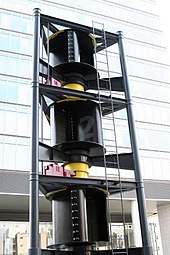Savonius wind turbine

Savonius wind turbines are a type of vertical-axis wind turbine (VAWT), used for converting the force of the wind into torque on a rotating shaft. The turbine consists of a number of aerofoils, usually—but not always—vertically mounted on a rotating shaft or framework, either ground stationed or tethered in airborne systems.
Origin
The Savonius wind turbine was invented by the Finnish engineer Sigurd Johannes Savonius in 1922 and patented in 1926.[1][2] Europeans had earlier experimented with curved blades on vertical wind turbines for many decades. The earliest mention is by the Bishop of Csanád County, Fausto Veranzio, who was also an engineer. He wrote in his 1616 book Machinae novae about several vertical axis wind turbines with curved or V-shaped blades. None of his or any other earlier examples reached the state of development achieved by Savonius. In his biography, there is mention of his intention to develop a turbine-type rotor similar to the Flettner rotor, but self-rotating. He experimented with his rotor on various small rowing craft on lakes in Finland. No results of his investigations are known, but the Magnus effect is confirmed[clarification needed] by Felix van König (1978).[3] Two Savonius wind turbine patents were filed in the U.S.: one in 1925 [4] and one in 1928,[5] by Savonius.
Operation

The Savonius turbine is one of the simplest turbines.
Power and rotational speed
According to Betz's law, the maximum power that is possible to extract from a theoretical ideal rotor is , where is the density of air, and are the height and diameter of the rotor and is the wind speed. However, in practice the extractable power is about half that [8] (one can argue that only one half of the rotor — the scoop co-moving with the wind — works at each instant of time) and depends also on the efficiency of the given rotor. Thus, for the theoretical ideal rotor, one gets , but the average maximum efficiency of the Savonius wind turbine is around 20% (),[9] making the real extractable power of the typical Savonius .
The angular frequency of a rotor is given by , where is the radius and is a dimensionless factor called the tip-speed ratio. λ is a characteristic of each specific windmill, and for a Savonius rotor λ is typically around unity.
For example, an oil-barrel sized Savonius rotor with h=1 m and r=0.5 m under a wind of v=10 m/s, will generate a maximum power of 120 W and a maximum angular speed of 20 rad/s (190 revolutions per minute).
Use

Savonius turbines are used whenever cost or reliability is much more important than efficiency.
Most
The most ubiquitous application of the Savonius wind turbine is the Flettner ventilator, which is commonly seen on the roofs of vans and buses[where?] and is used as a cooling device. This rotor was developed for ventilation by the German aircraft engineer Anton Flettner in the 1920s.[10] It uses the Savonius wind turbine to drive an extractor fan. The vents are still manufactured in the UK by Flettner Ventilator Limited.[11]
Specifically constructed Savonius wind turbines have been used to provide power to autonomous neutrino detector stations of the ARIANNA experiment on the Ross-Ice Shelf in Antarctica. [12]
In Europe, small Savonius wind turbines can sometimes be seen used as "animated" advertising signs in which the rotational movement helps to draw attention to the item advertised. They sometimes feature a simple two-frame animation.[citation needed]
Tethered airborne Savonius turbines
- Airborne wind turbines
- Kite types
- When the Savonius rotor axis is set horizontally and tethered, then kiting[autorotationof the Savonius rotor. The spin may be mined for some of its energy for making sound, heat, or electricity.
Gallery
-
Operation of a Savonius turbine
-
A Savonius rotor bladed WECS
References
- ISBN 9783030188153.
- ISBN 9781118794180.
- ISBN 3-7906-0077-6.
- ^ US1697574
- ^ US1766765
- ^ Duval, George (July 24, 2021). "What's the Difference Between Vertical and Horizontal Wind Turbines?". Semprius. Retrieved November 11, 2021.
- ^ "Improved Savonius wind turbine captures wind in the cities". ScienceDaily. May 20, 2016. Retrieved November 11, 2021.
- ^ "Increase in the Savonius rotors efficiency via a parametric investigation". ResearchGate. Retrieved 2017-06-02.
- ^ "Increase in the Savonius rotors efficiency via a parametric investigation". ResearchGate. Retrieved 2022-08-20.
- ^ Freehill-Maye, Lynn (December 1, 2020). "Rotating Sails Help to Revive Wind-Powered Shipping". Scientific American. Retrieved November 11, 2021.
- ^ Flettner
- .














